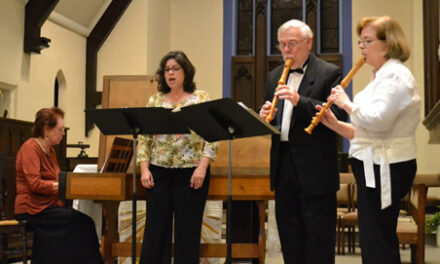Yewon Ahn of the North Carolina Symphony presented solo recitals in the Triangle this week, the latest a stunning, intimate parlor performance at the Searstone Retirement Community in Cary, collaborating with Dr. Kent Lyman, Steinway Artist and professor at Meredith College.
Ahn, cellist with NCS since 2018, began solo with the Prelude and Gigue from JS Bach’s Cello Suite No. 3 in C, BWV 1009. Her tone was rich, dark, and resonant through the opening scales, with relaxed rubato and deliberately phrased chords achieved through deftly bowed double stops. She was able to exploit the effect of playing over a continuo, especially through the rhythmic Gigue, which had an infectious, dance-like feel. Even when rapidly crossing strings, Ahn’s strokes were crisp and precise.
Dr. Lyman joined Ahn for Luigi Boccherini’s Sonata No. 6 in A (the first two movements – Adagio and Allegro). Ahn’s tone was tighter and more reflective of a Baroque solo instrument during these selections – appropriately, as the sonata gives the cello long, singing lines that are flanked by the harmonic architecture of the piano. Ahn’s playing was soft but never unfocused, and her nimble playing at her softest dynamic was remarkable. More dramatic double stops built tension within a continually tender and delicate framework. The second movement was racing and exciting, with impressive, rapid sequential figures that built to a large concerto but gracefully pulled back instead of exploding in resolution. The understatement throughout the composition added to an overall air of refinement and effortlessness exemplified by both Ahn and Lyman throughout the evening.
Robert Schumann’s Concerto in A minor, Op. 129, was the meatiest part of the program, a three-section tour-de-force that largely went unperformed until many years after the composer’s death. Calvin Dotsey, writing for the Houston Symphony in 2020, muses that “the work is quite technically demanding,” but “it prizes poetic expression above virtuoso display” and can therefore be less gratifying as a solo showcase. The plaintive, emotional opening immediately casts the piano as a collaborator rather than accompaniment – highlighting both Schumann’s excellence in piano composition, and Lyman’s thoughtful musicianship. Ahn presented new timbres, from growling, expressive low register to pleading high register. The musicians expertly utilized silence and space – effective in the plush, carpeted room – that lent the performance moments of startling sparse dryness. The interaction between parts is complex yet Ahn’s communication was always clear.
Honestly, I lost track of where one section of this work ended and the next began, but that added to the composition’s sense of poetry. It evolved from one motive to the next, the momentum of the piece ebbing and flowing dazzlingly in a complicated interplay between the two parts. Ahn began, after a tender and devastatingly soft melody, to spur the movement onwards, growing the intensity with impressive, leaping motion down the fingerboard that still never lost clarity, finally unleashing her boldest, most passionate playing yet – before a sudden halt into a dreamlike cadenza section. Lyman contributed understated, almost pointillistic chords that outlined an increasingly rollicking and developing final excursion by Ahn, through to the end of the work.
A final treat at the end of this jam-packed concert (clocking in at a tight 50 minutes), Ahn and Lyman performed Camille Saint-Saens’ Allegro Appassionato in B minor, Op. 43. This work is a full and rich Romantic encore, more melodic and linear than Schumann but utterly celebratory and elegant. Ahn toyed with expectations by briefly suspending the tempo, exaggerating a lovely downward glissando, and seeming to delight in looser, showier passages that allowed for a gratifying outpouring of emotion (and earning an amazed “Wow!” from the audience member behind me) as the recital concluded. Ahn and Lyman both possess understated performing personas, relishing moments where they can take their time, but that seems to make it all the more captivating when they are finally able to let loose and let the music sweep them up.












